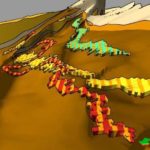
This course provides students with the necessary knowledge and the related skills for exploiting data in modern computing problems (particularly, in visual computing), along with general competence in data-oriented visual computing.
Introduction
Business as well as research is increasingly influenced by data-driven discoveries and prediction. This course focuses on foundations for data-intense informatics projects, in particular projects involving visual computing. Those foundations include the necessary mathematical basis (more from a users¿ point of view) as well as programming foundations. Students of this course acquire the competence and skills that are required for realizing a data-intense project from start to end, i.e., from analyzing data to visualizing and communicating the results. The course provides students with a broad foundation of methods and techniques in data science and introduces the most important computational data analysis techniques with an emphasis on their conceptual basis as well as their practical utilization.
Prerequisites
The course requires a moderate understanding of mathematics (basics of linear algebra) and good knowledge of programming. It should be taken in the second half of a 3-years Bachelor program in Informatics. The course requires basic knowledge of programming and mathematics from earlier University education. Students should have passed at least one basic course from mathematics (ideally with basic training in linear algebra), and at least two courses about programming.: INF100 and INF101 (or a comparable education); MAT101 (or MAT111, or any other comparable course).
Learning Outcomes
Knowledge:
- Students will exemplify an understanding of common data fitting and optimization techniques and their applications.
- Students will be able to carry out numerical integration and derivation methods.
- Students will know to apply basic statistical methods and basic machine learning.
Skills:
- Students will demonstrate an understanding of linear systems and will be able to exploit them in data-oriented computation.
- Students will adapt in practice selected principles of image processing and visualization.
- Students will be able to design computer programs for data analysis and scientific computing.
- Students will practice programming that exploits special opportunities (like exploiting the graphics card).
General competencies:
- Students will judge the appropriateness of applying different data analysis techniques.
- Students will organize and structure the problem solving approaches in a team environment.
Course Access
This course is open to all students of natural sciences, in particular informatics, who do have a minimum qualification in mathematics (basic in linear algebra) and a good command of programming from earlier University education, especially students from Bachelor programs in Informatics at UiB.
Students, who consider to later take the Master program in visualization at UiB Informatics (MAMN-INF/VI), are strongly recommended to take this course in the second half of their Bachelor studies.
Course Structure
The course is built upon lectures, programming tutorials and programming assignments, as well as exercises. On average, students will meet up for lectures, tutorials, and exercises for 6 hours per week.
Compulsory Assignments and Attendance
The exercises must be attended. The programming assignments will be evaluated and must be passed. An exam (about the content of the lectures) needs to be passed, as well. Compulsory assignments are valid two semesters, the semester of the approval and the following semester.
Forms of Assessment
At the end of the semester there is a written exam (three hours). If less than 20 students are taking the course, the exam can be oral.
The exam is a closed-book exam, where only approved calculators are allowed.
The overall evaluation of the course is then a combination of the grading of the programming assignments and the exam.
Grading Scale
The grading scale used is A to F. Grade A is the highest passing grade in the grading scale, grade F is a fail.
Subject Overlap
No overlap
